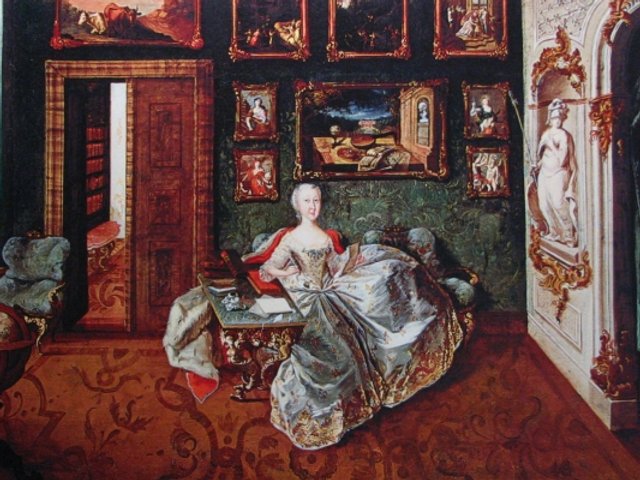The “princess who knew a lot and asked a lot of questions” sounds like a character from a fairy tale. It was, however, how Johann Kaspar Lavater referred to Karoline Luise of Baden (1723-83), one of the most remarkable connoisseurs and dilettanti of the 18th century. The daughter of the count of Hessen-Darmstadt, she grew up in a household burdened with staggering debts but mindful of the education of its offspring. From the age of ten she was educated in an encyclopaedic range of subjects for up to 52 hours a week, in addition to receiving instruction in the piano and in drawing. By the time of her marriage to the margrave of Baden in 1751 she was already celebrated as the “Hessian Minerva”; by the time of her death she was revered by the leading intellectuals of the day and had been made an honorary member of the Danish Academy of Fine Arts.
An encounter with Jean-Etienne Liotard in 1745 at the coronation of Francis I in Frankfurt resulted in a portrait of the young princess, and several weeks of lessons in the art of pastel painting. Following her marriage to Karl Friedrich of Baden, Karoline Luise not only continued to draw and paint but also assembled a notable “cabinet de tableaux”. She did not collect for display or to demonstrate wealth or status. She regarded the “cabinet” much as she regarded her extensive library or her botanical and geological collections: as a work of reference, models for guidance and inspiration. Significantly, these pictures were not on public display, but kept for her private pleasure and ultimately housed in four mansard rooms to which she alone had easy access.
Between 1759 and 1770 Karoline Luise had paintings bought at auctions in Paris, Rome, Amsterdam, The Hague and Strasbourg. A network of correspondents informed her about what was available and the likely prices. From the outset she kept a close eye on her expenditure; and when prices rose after 1770 she declared herself unable to afford what she wanted, and bought nothing more.
From the start, Karoline Luise had a clear agenda: to acquire works by the Flemish masters of the Baroque, by Dutch 17th-century painters and French 18th-century artists who painted in the Dutch style. Italian painting or Watteau and his followers did not interest her; she acquired only a handful of German, Italian and English works.
The highlights were undoubtedly works by Rembrandt, Teniers and Chardin but the collection as a whole reflected a concern with quality and some rather specific requirements. She liked her pictures to be densely painted; she did not approve of sketches or paintings on which brushstrokes were visible; and with very few exceptions, she always bought small pictures.
After Karoline Luise’s death, her husband transferred the 205 works that she had collected to a drawing academy within the palace grounds, where they were used in teaching but also made accessible to the public. Some were subsequently sold, but 151 pictures remain in the Karlsruhe Kunsthalle. Last year, they formed the focus of a spectacular exhibition in Karlsruhe. The sumptuous illustrated catalogue Die Meister-Sammlerin provides full documentation and a wealth of contextual information. A further volume, Aufgeklärter Kunstdiskurs und höfische Sammelpraxis situates this extraordinary individual in her European context. The same research team involved in these books will shortly publish Karoline Luise’s correspondence online together with images of all the pictures. The “Hessian Minerva” will thereby finally receive lasting recognition.
• Joachim Whaley is the professor of German history and thought at the University of Cambridge and a fellow of the British Academy
Die Meister-Sammlerin: Karoline Luise von Baden
Holger Jacob-Friesen and Pia Müller-Tamm, eds
Deutscher Kunstverlag, 544pp, €39.90 (hb)
Aufgeklärter Kunstdiskurs und höfische Sammelpraxis: Karoline Luise von Baden im europäischen Kontext
Christoph Frank and Wolfgang Zimmermann, eds
Deutscher Kunstverlag, 280pp, €29.90 (hb)
Both books in German only



